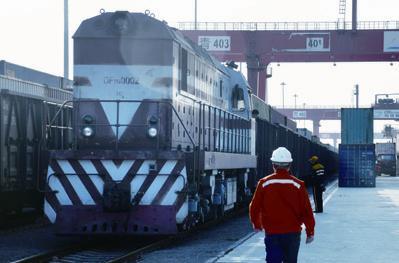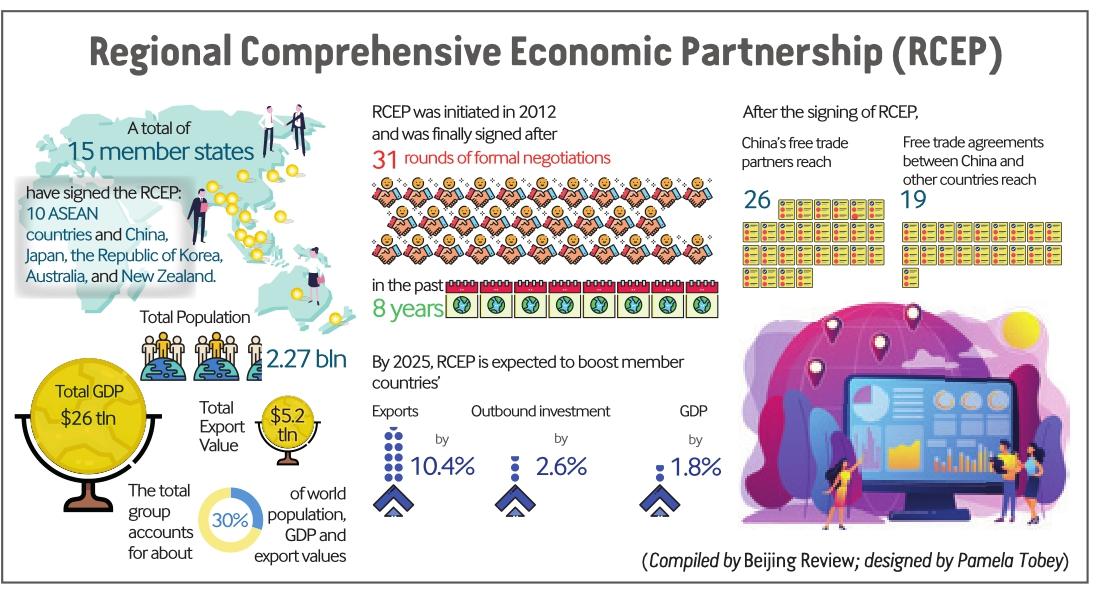MARCH FORWARD
Song Qingrun, associate professor at the School of Asian Studies, Beijing Foreign Studies University
RCEP countries have a combined population of 2.27 billion or about 30 percent of the worlds total. In comparison with the U.S.-Mexico-Canada Agreement (USMCA) and the EU, each of which covers around 500 million people, the RCEP offers more opportunities and greater market potential. Additionally, according to data from the International Monetary Fund, the total GDP of the 15 members reaches some $26 trillion, which is equivalent to or slightly higher than that of the three USMCA countries, and exceeds that of the EU.
The new deal is significant for its inclusivity and the diversity of its signatories. While the EU is composed of developed countries and the USMCA consists of two developed countries and one of the worlds most advanced developing countries, the development disparity among the 15 RCEP countries is huge. But the agreement strikes a balance of interests between the developed and developing members in the areas of market access and regulation of goods, services and investment.
The signing of the RCEP shows that all members are committed to lowering tariffs, opening markets and reducing standard barriers, sending a strong message against unilateralism and protectionism. The joint leaders statement on RCEP stated, “The signing of the RCEP agreement demonstrates our strong commitment to supporting economic recovery, inclusive development, job creation and strengthening regional supply chains as well as our support for an open, inclusive, rules-based trade and investment arrangement.”
The RCEP is expected to boost regional development, enhance East Asias status as an important engine of world economic growth, and contribute to global economic recovery in the post-pandemic era.
Li Dongxin, associate professor at Shandong University
The RCEP speaks volumes for the determination of countries to stick together and counter the anti-globalization tide. It represents the interests of developing members in global economic and trade governance, and is set to break the status quo of international economic and trade regulations established by developed countries, mainly in the pursuit of self-interest.

After the deal becomes effective, 90 percent of the goods traded between the 15 member countries will be tarifffree, though this number may not be the highest in comparison to other free trade agreements (FTAs). Moreover, the RCEP does not set strict conditions for participating countries regarding intellectual property, the labor market and environmental protection. This demonstrates how the quest for growth lies at the core of the interests of developing members.
The novel coronavirus disease(COVID-19) pandemic has taken a heavy toll on economies across the world. The signing of the RCEP will contribute to global economic recovery by providing a muchneeded boost for the Asia-Pacific region and the world at large.

It also has implications for the cooperation among China, Japan and the Republic of Korea (ROK). The China-Japan-ROK FTA was first proposed in 2002. After 18 years of negotiations, the three countries have yet to conclude the process. The RCEP can add to their mutual political trust. Meanwhile, the partnership will further reduce trade barriers, laying solid foundations for the China-Japan-ROK FTA negotiations to move forward.
George N. Tzogopoulos, Director of the EU-China Program at the Centre International de Formation Européenne
China is largely seen as the main winner of the RCEP conclusion. Although the country will certainly benefit by the new partnership agreement, it is not looking for any type of victory in contrast to public perceptions. Its diplomacy, including its economic diplomacy, is calm and systematic, and counts on deeds rather than words. China does not act alone but in coordination with its trading partners.
The RCEP has been the result of difficult negotiations which began in 2012. Where China deserves special credit is its determination to act responsibly in the Asia-Pacific region. The country was active in the talks and finally reached common ground with the other 14 signatories. All of them seek to preserve free trade in order to strengthen their national economies.
The timing is also significant. The result of the U.S. presidential election did not generate second thoughts among some signatories. The world is progressing and is certainly different from what it was four years ago. Potential new initiatives by the U.S. will need to be carefully studied but the 15 RCEP signatories have already exhibited their interest in responding together to rising economic challenges in the Asia-Pacific region.
More importantly, the RCEP will connect 2.27 billion people, approximately 30 percent of the worlds population and output. It will empower regional supply chains by offering a boost to local small and medium-sized enterprises (SMEs). In the meantime, the Belt and Road Initiative has the potential to unleash growth via investment, increasing the competitiveness of local SMEs.

